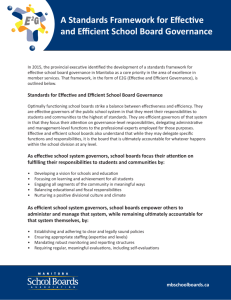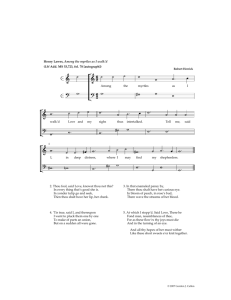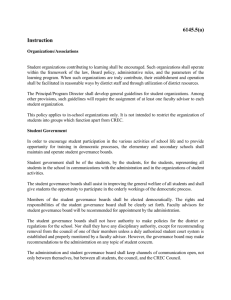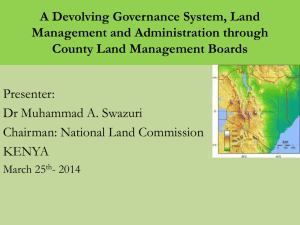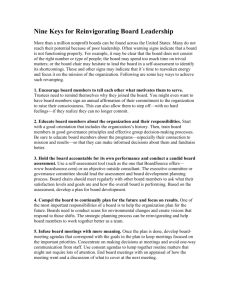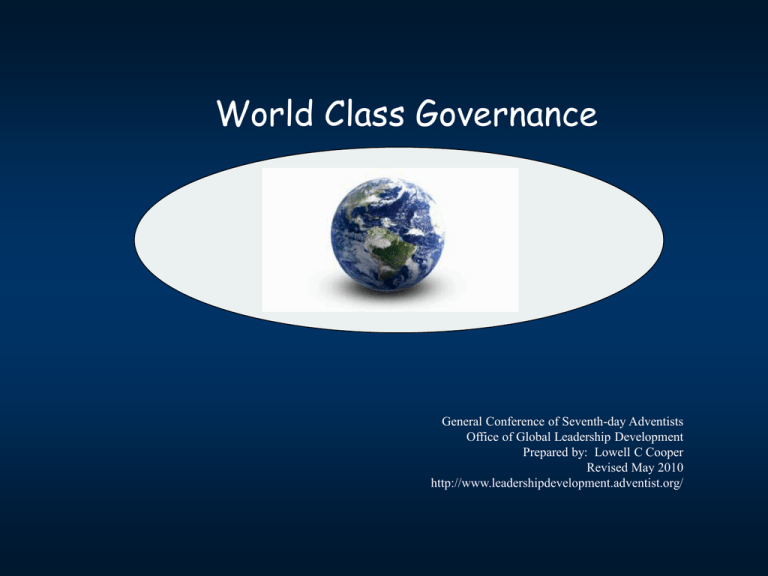
World Class Governance
General Conference of Seventh-day Adventists
Office of Global Leadership Development
Prepared by: Lowell C Cooper
Revised May 2010
http://www.leadershipdevelopment.adventist.org/
Legal Notice and Terms of Use
Copyright 2010 by the General Conference of Seventh-day Adventists®. All rights reserved. The
information is provided for training purposes only and is not intended nor should it be used as legal
counsel. This program may not be used or reformulated for any commercial purposes; neither shall it
be published by any person or agency other than an official organizational unit of the Seventh-day
Adventist® Church, unless prior written authorization is obtained from the General Conference of
Seventh-day Adventists® Office of Global Leadership Development. Subject to the foregoing
terms, unlimited permission to copy or use this program is hereby granted upon inclusion of the
copyright notice above. “Seventh-day Adventist” and “Adventist” are registered trademarks of the
General Conference of Seventh-day Adventists® and may not be used by non-Seventh-day Adventist
entities without prior written authorization from the General Conference. Use of all or any part of
this program constitutes acceptance by the User of these terms.
Why board processes matter:
1. Most leadership training is for individualized
positions of responsibility. Most major decisions are
made in groups.
2. Effective group decisions do not arise
spontaneously. They result from deliberate designs
in structure and social dynamics.
3. Many governance weaknesses and mistakes arise
from inadequate attention to group responsibilities
and processes.
4. The pursuit of excellence in such matters is
worthwhile…because God’s work deserves such.
3
Our challenge:
“…there is one thing all boards have in
common, regardless of their legal
position.
They do not function.”
Peter Drucker
4
Our challenge:
“Effective governance by the board of a
nonprofit organization is a rare and
unnatural act...”
Taylor, Chait and Holland
“The New Work of Nonprofit Boards”
Harvard Business Review, Sept-Oct 1996
5
Our challenge:
“Though possessed of ultimate
organizational power, the governing
board is understudied and
underdeveloped…where opportunity for
leadership is greatest, job design for
leadership is poorest.”
--John Carver
6
Our challenge:
“The development of all our powers
is the first duty we owe
to God and to our fellow men.
No one who is not growing daily
in capability and usefulness
is fulfilling the purpose of life.”
--E G White Christ’s Object Lessons, p 329-330
7
“If things seem under control...you’re
just not going fast enough.”
—Mario Andretti
8
9
7 Signs of Ethical Collapse:
1.
2.
3.
4.
5.
6.
7.
Pressure to maintain those numbers
Fear and silence (dissent not tolerated)
Bigger-than-life president/CEO, aspiring
colleagues
Weak boards
Conflicts of interest not addressed
Success is all that matters
Goodness in some areas atones for evil in
others
10
Boards and Committees
11
SDA Governance Structures:
Boards
Executive Committees
12
SDA Governance Structures:
Boards
Executive Committees
• Stand-alone entities
• Part of a network
13
SDA Governance Structures:
Boards
Executive Committees
• Stand-alone entities
• One employee member
• Part of a network
• Many employee members
14
SDA Governance Structures:
Boards
Executive Committees
•
•
•
•
•
•
•
•
•
•
Stand-alone entities
One employee member
External chairperson
Limited hiring decisions
Incorporated status
Part of a network
Many employee members
Internal chairperson
Multiple hiring decisions
Unincorporated status
15
Governing board
• Has ultimate corporate authority
• Total authority matched by total
accountability
• Can be superseded only by organization’s
owners or by the state
• In SDA structure the owner is the
constituency, or “membership” defined in the
bylaws
16
Governance and management:
Governance:
– Requiring
accountability by
setting goals and
evaluating
performance
– Setting strategic
plans and major
policies
– Overseeing
implementation of
plans/policies
Management:
– Implementing plans
and policies
– Managing day-to-day
operations
– Reporting on
performance
17
What good boards do:
1. Shape mission and strategic direction
2.
3.
4.
5.
6.
7.
8.
9.
Maintain SDA identity of organization
Establish key policies and strategies
Select, develop, and evaluate officers
Ensure adequate financial resources
Build/enhance organization’s reputation
Provide adequate risk management
Assess performance against mission
Improve board performance
18
What goes wrong on boards:
• Time consumed is not proportional to results.
• Tendency to drift:
•
•
•
•
•
– from strategy to operations (from long-term to short-term)
– from governance to management
– from collective action to individual initiatives
Driving by the rearview mirror
Reactive stance rather than proactive
Leaky accountability
Uncertainty over boundaries of authority
Deluge of data, lack of big picture
19
Complaints of board members:
• “My presence is basically immaterial to
the outcome. We are like accomplished
musicians unable to play a symphony
together.”
• “Meetings are boring, agenda tightly
scripted, outcomes predetermined,
opportunity to influence decisions
severely limited.”
20
Pathways to progress
•
•
•
•
•
•
•
Board/committee composition
Board policies
Director/trustee orientation
Conducting effective meetings
Role of the chairperson
Creating good social dynamics
‘999’ Plans
21
Board/Committee composition:
•
•
•
•
•
•
•
•
Compliance with governance documents
Determine expertise/diversity range needed
Establish constituency representation pattern
Outline expectations of directors
Select people with expertise and time
Create a member education agenda
Consider the value of staggered terms
Factor the effect of board size
22
Considerations for Board membership
• How well does the person work in a group?
• What is the person’s reputation?
• Is the person capable of understanding the
institution’s mission and work?
• Can the person overcome territorialism?
• Can the person commit sufficient time?
• Does the person contribute to the skill set?
23
Board policies: (Sarbannes-Oxley)
•
•
•
•
•
•
•
•
•
•
•
Conflict of Interest
Independent trustee
Executive compensation/bonuses
Contemporaneous documentation of meetings
Provide Form 990 to the Governing Body
Prohibition: retaliation against whistleblowers
Record retention and destruction policy
Rebuttable presumption of reasonableness
Joint ventures
Expenditure limits of execs
Number of meetings.
24
Board policies:
• Code of ethics
• Safe reporting mechanism for ethical conduct
violations (non-retaliation policy)
• Conflict of interest policy/procedures
• Confidentiality
• Conflict resolution--grievance/mediation
• Number of meetings per year
• Authority of execs and committees
25
Employees stunned most academics by saying
that the code of ethics for their company had
very little influence on whether they made
ethically correct choices. It was the culture
of their companies and the examples set by
their leaders that influenced their conduct.
—from a 2004 study by the Journal of Business Ethics
26
Conflicts of interest:
Three basic rules:
Declare
Decide
Document
27
Directors/Trustees
• As a body, a board of directors has
considerable power. An individual director,
acting alone, has almost no power.
• Relate to several parties or interests:
– constituency which elected/appointed him/her
– constituency of service (i.e. students)
– constituency of accountability (i.e. gov’t)
28
What directors need to know:
•
•
•
•
•
•
•
•
•
Who selected him/her?
What is the term of service? Re-electable?
What is expected from the director?
What is organization’s purpose?
What constituencies are served?
What corporate documents exist…?
What parties can question decisions?
What protection is there against liability?
What are director/member’s rights?
29
Director/member rights:
•
•
•
•
Access to management
Access to records and documents
Attendance at meetings
Prerogative to vote
30
Duties of Board Members
Care
Loyalty
Obedience
31
The duty of care
•
•
•
•
•
•
•
•
Refers to the level of competence expected
Common standard: “ordinary prudent person”
Duty to attend meetings regularly
Duty to show independent judgment in voting
Duty to be informed
Duty to rely on/delegate to trusted sources
Duty of diligence (perfect judgment not required)
Duty of risk management …
32
The duty of loyalty
•
•
•
•
Corporate position not for personal advantage
Standard of faithfulness to the organization
Undivided allegiance when making decisions
Duty of loyalty breached when members use
organizational property for personal purposes
• Maintaining confidentiality of privileged info
33
The duty of obedience
• Making sure the organization remains
obedient to its purpose and role (i.e. faithful to
SDA mission, beliefs, culture, policies and practices)
• Duty of compliance with laws
• Fulfilling commitments, including previous
ones
34
Board member orientation:
•
•
•
•
•
•
•
Director’s handbook
Legal documents
Organizational chart
Meetings (time and frequency)
Committee structures, if any
Fiduciary responsibilities
Expectations of trustees
35
Conducting effective meetings:
• Conduct meetings on a regular basis.
• Supply agenda information and reports in
advance.
• Help senior management determine “what
matters most” (avoid syndrome of “everything
matters most”).
• Careful attention to agenda sequencing.
• Create opportunity for CEO to think out loud.
36
Conducting effective meetings:
• Encourage experimentation.
• Monitor progress and performance (define
the dimensions of success).
• Model desired behaviors.
• Establish basic rules of conduct.
• Draft recommendations in advance.
• Conduct orientation for new board members.
• Involve all members.
37
Conducting effective meetings:
• Affirm the appropriate role of the chair.
• Think carefully about seating arrangements.
• Focus on decision-making that is informed by
the mission statement.
• Timely publication of minutes.
• Conduct board evaluation and retreats…
• Encourage good social dynamics.
• Regularly review the board’s code of ethics,
including conflict of interest policies.
38
The role of the chairperson
• Before the meeting begins.
• During the meeting.
• After the meeting.
39
Before the meeting begins:
•
•
•
•
•
•
•
Orientation of new members
Appropriate notice of meeting
Conduct meetings on a regular basis
Supply agenda info and reports in advance
Awareness of agenda items
Determine pace and sequence of agenda
Use a consent agenda for items that can be
approved without further discussion
40
During the meeting:
• Call to order
• Define the dimensions of success for the
meeting
• Establish basic rules of conduct (use of cell
phones, private conversations)
• Executive/privileged sessions
• Keep group focus on agenda
• Draft recommendations in advance
41
During the meeting (cont’d):
•
•
•
•
•
•
Maintain orderly processes (rules of order)
Encourage good social dynamics
Call for the vote (in favor and opposed)
Create opportunities to think aloud
Arrange for board/committee education
Close the meeting
42
Creating good social dynamics:
• Physical arrangements (seating, lighting,
sound) of the meeting place.
• A virtuous cycle of respect, trust and candor.
• Minimal impact of political factions.
• A culture of open dissent encouraged.
• Be careful not to confuse dissent with
disloyalty.
43
“…the highest-performing companies have
extremely contentious boards that regard
dissent as an obligation and that treat no
subject as un-discussable.” —Sonnenfeld, ibid.
44
Creating good social dynamics:
(cont’d)
• Deliberately develop/examine alternatives.
Challenge cherished roles and assumptions.
• Give board members meaningful tasks that
involve accountability.
• Regular evaluation of a group’s performance.
45
Following the meeting:
•
•
•
•
Verify accuracy of minutes
Keep in touch with absentees
Maintain communication with CEO
Monitor implementation of actions
46
And while the Great Ones repair to their
dinner, the Secretary stays, growing thinner
and thinner. Racking his brains to record and
report what he thinks they will think they
ought to have thought.
London Institute of Directors
1971 Standard Manual
47
Board member preferences:
• Agenda materials—how and when received
• Minutes—how and when received
• Board meetings:
– Reports: when and how many
– Major discussion issues: first or last
48
Governance best practices:
•
•
•
•
•
Create and use board member selection criteria.
Insist on mandatory orientation and on-going educ.
Create master board calendar (and website).
Conduct board evaluations.
Review board structure, composition, and policies on a
regular basis.
• Conduct rigorous review of conflict of interest
declarations.
• Clarify roles, responsibilities, and authority.
• Focus on effective meetings.
49
Effective meetings:
• Stay on the governance level.
• Provide agenda materials in standard formats, with
executive summaries, in advance.
• Use consent agenda for routine items.
• Create and monitor ‘dashboard’ performance
indicators.
• Facilitate conversations that build consensus. (Rules
of order can be misused.)
• Develop and support healthy board culture.
• Use a meeting evaluation tool to obtain feedback.
50
Effective governance culture:
Expertise: Quality and range of director
expertise fits the organization.
Environment: Board meeting is a safe
place to talk.
Engagement: Assumptions are examined,
differing views are welcome.
Emphasis: Clarity of strategic intent
informs decision-making.
51
Ten Commandments for Trustees
• Thou shalt remember that
board members have no
authority to act alone.
• Thou shalt love, honor, and
support the organization.
• Thou shalt serve the interest
of the owners and not thine
own interests.
• Thou shalt do thy homework.
• Thou shalt present thyself at
board meetings and pay
attention.
• Thou shalt trust the work of
board committees.
• Thou shalt discipline thy
mind before speaking it.
• Thou shalt not throw hand
grenades at any time.
• Thou shalt let management
manage.
• Thou shalt give thy attention
to the organization’s mission
and its future.
52
‘999’ Plans
What can be done to improve _____
Board functioning in the next 9 days?
What can be done to improve _____
Board functioning in the next 9 weeks?
What can be done to improve ____
Board functioning in the next 9 months?
53
Acknowledgements:
•
•
•
•
•
•
•
•
•
•
•
Boards That Make a Difference, 2nd edition, John Carver, Jossey-Bass
Publishers, San Francisco
Guidebook for Directors of Nonprofit Corporations, Section of Business
Law, American Bar Association
Meeting the Challenge, Video, BoardSource—formerly the National
Center for
Nonprofit Boards
Ten Basic Responsibilities of Nonprofit Boards, Richard T Ingram,
BoardSource
The Board Meeting Rescue Kit, BoardSource
What Boards Are Supposed To Do, The Governance Institute
“What Makes Great Boards Great”, Harvard Business Review,
September 2002
The Association of Governing Boards, Washington, DC.
Hansen, Kent—Attorney, various documents and seminar presentations
Hiroshima, Phil—Attorney, various documents and seminar
presentations
Nixon, Robert—Attorney, various conversations and presentations.
54
End
55

